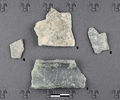BZ-26: Difference between revisions
No edit summary |
No edit summary |
||
| Line 12: | Line 12: | ||
|language=Raetic | |language=Raetic | ||
|meaning=unknown | |meaning=unknown | ||
|object=BZ-26 | |object=BZ-26 fragment | ||
|position=rim | |position=rim | ||
|orientation=0 | |orientation=0 | ||
Revision as of 17:38, 17 February 2015
| Inscription | |
|---|---|
| Transliteration: | ?]i : perisṇ[ |
| Original script: | ] |
|
| |
| Object: | BZ-26 fragment (bronze) |
| Position: | rim |
| Orientation: | 0° |
| Script: | North Italic script (Sanzeno alphabet) |
| Direction of writing: | sinistroverse |
| Letter height: | 1.7 cm |
| Number of letters: | 7 |
| Number of characters: | 8 |
| Number of lines: | 1 |
| Craftsmanship: | engraved |
| Current condition: | damaged, fragmentary |
| Date of inscription: | 2nd half of the 5th century–1st century BC [from object] |
| Date derived from: | typology [from object] |
|
| |
| Language: | Raetic |
| Meaning: | unknown |
|
| |
| Alternative sigla: | none |
Images
|
Object BZ-26 fragment with inscription BZ-26.
|
Object BZ-26 fragment with inscription BZ-26 (fragment 1).
|
Commentary
First published in Lunz & Morandi 2003: 345 ff.
Images in Lunz & Morandi 2003: Fig. 3 (photo) and 4 (drawing).
Length of the remains 5.5 cm. The lines are thin, but well visible; the reading is unambiguous. On the right, the remains of two vertical lines, the left of which can hardly be anything else than ![]() . The separator consists in three short vertical scratches, and does not come up to the height of the letters. The hasta of
. The separator consists in three short vertical scratches, and does not come up to the height of the letters. The hasta of ![]() is inclined in writing direction; the second bar of
is inclined in writing direction; the second bar of ![]() runs along the breaking edge. The identification of the first letter after the separator as
runs along the breaking edge. The identification of the first letter after the separator as ![]() (rather than
(rather than ![]() or
or ![]() ) is indisputable; see SL-1 and ??? for a discussion. We can amend to perisna. Cp. BZ-4, where this word is preceded by ipi, which matches the remains of letters before the separator and might conceivably be the case here as well. Cp. also BZ-27.
) is indisputable; see SL-1 and ??? for a discussion. We can amend to perisna. Cp. BZ-4, where this word is preceded by ipi, which matches the remains of letters before the separator and might conceivably be the case here as well. Cp. also BZ-27.
Bibliography
| Lunz & Morandi 2003 | Reimo Lunz, Alessandro Morandi, "Un frammento di elmo di bronzo con iscrizione retica da Settequerce – Siebeneich", Archeologia Classica LIV (2003), 341–349. |
|---|

